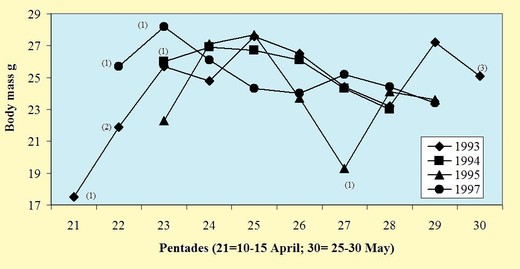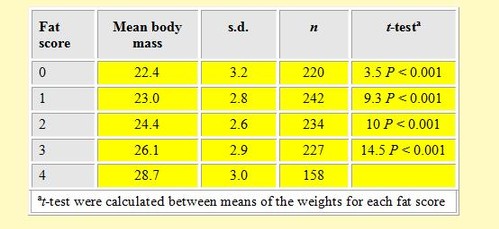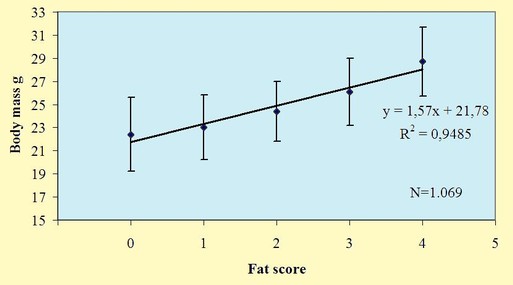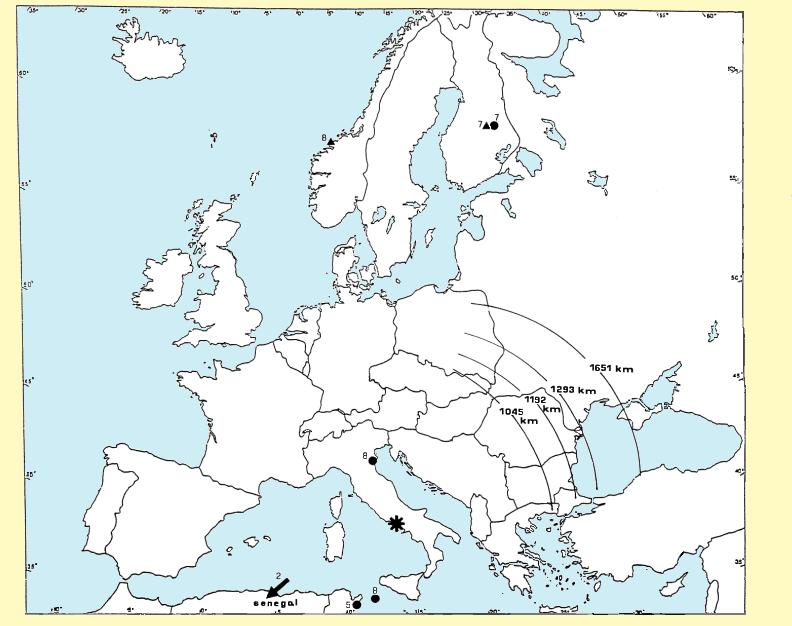Calidris minuta - Gruppo Inanellamento Limicoli (GIL, Napoli)
Menu principale:
- Home Page
- L'Associazione
-
Ricerche in atto
- Migrazione autunnale Allodola
- Migrazione primaverile Tordo
- Ali Tordo bottaccio in Campania
- Stazione Monte Vaccaro
- Riserva Naturale Foce Volturno
- Inanellamento Medio Volturno
- Avifauna svernante
- Avifauna Foce Neto e Sila
-
Ricerche concluse
- Ali Turdidi e Beccacce ATC LT 2
- Stazione Malga Rosello
- Migrazione Caradriiformi
- Progetto Rondine
- Migrazione autunnale Tordo
- Ali Turdidi e Beccacce ATC CE
- Progetto Alauda 2000
- Osservatorio Roccolo Ganda
- Atlante Migrazioni Puglia
- Download
- News
Calidris minuta
Fat reserves of Little Stint Calidris minuta in a stopover site in southern Italy
Sergio Scebba & Giancarlo Moschetti
Atti XI Conv. ital. Ornit., Castiglioncello. In: Avocetta (2001) 25, Supplemento: 67.
Introduction
The Volturno Plain, a stopover site in the central Mediterranean near the southern Italian coast, is regularly visited by large flocks of Little Stints Calidris minuta during northward migration. The present paper provides general information on fat reserves and flight range of Little Stints ringed by the "Gruppo Inanellamento Limicoli (G.I.L., Naples)", that carried out studies on wader migration in this area since 1991.
Study area and methods
The work was carried out on the Volturno Plain, Caserta (southern Italy). This area contains many artificial ponds varying in size from 0.5 ha to c.5 ha, used in winter for waterfowl shooting. In total, 2021 Little Stints were mist-
Body mass was measured using Pesola spring balances to the nearest 0.1 g or on a digital balance. In this study we used a new visual method to evaluate fat deposition, according to a scale from 0 to 4, based on the observation that in waders species there is fat deposition in the part of the body comprised between the articulation of the wing and the articulation of the leg (see Scebba & Moschetti in press for details).
To estimate potential flight range were used four models published in Davidson (1984), based on estimates of flight speed and metabolism.
Analysis of body mass
The mean body mass during the period of catching (14 April-

Figure 1. Variation in body mass per pentades of Little Stints Calidris minuta trapped during northward migration 1993, 1994, 1995 and 1997. Pentades 21 = 11-
In this study we attempted to carry out a new visual method to evaluate the fat deposition in this species. Therefore, we attributed a fat score on the basis of fat accumulation. The results of the corresponding mean weights per fat score showed that there were significant relationships between the body weight of birds and visually estimated fat deposits (Pearson correlation coefficient =0.974): a higher weight corresponds to a higher fat score, with a statistically significant difference between the means of each weight per fat score. Moreover, there is an close correlation between fat scores and means of each weight per fat score (Table 1 and Figure 2).

Table 1. Relationship between fat score and body mass of Little Stints Calidris minuta trapped on the Volturno Plain, southern Italy, 1993-

Figure 2. Correlation between fat score and body mass of Little Stints caught on the Volturno Plain.
Body mass variation of retrapped birds and length of stay
25 Little Stints out of 2.021 were caught twice within the same period and weighed again. 13 birds showed a decrease in body mass of 0.8 g/day (max 5.5 g, min 0.2 g) after 0.5-
Flight range
For an estimation of potential flight range, both mass at arrival (lean mass) and departure mass (total mass at start) must be known. In this study we used for the estimation of potential flight range as lean mass and as departure mass the main weight calculated respectively for the lower and for the higher class of fat score identified in our stopover site (Table 1). However, while the lean mass used by Zwarts et al. (1990) and Meininger & Schekkerman (1994) is very similar to that calculated with the fat score 0 (22.1 g and 22.4 g, respectively), there is a great difference between the average departure mass calculated by Meininger & Schekkerman (1994) at Lake Manzala (Egypt) and our departure mass (34.6 g and 28.7 g, respectively).
At the flight speed of 55 km/h recorded for waders and based on field observations (Zwarts et al. 1990), the four models used fields still-

Figure 3. Ringing and recovery sites of Little Stints Calidris minuta controlled (circles) or ringed (triangles) during northward migration on the Volturno Plain with estimates of potential flight range. Numbers denote ringing month (for foreign birds) and recovery month (for birds ringed on the Volturno Plain). Asterisk = study area.
The resulting potential flight range estimates are lower than those calculated for birds leaving Egypt (Meininger & Schekkerman 1994). However, the distances mentioned above could be underestimated. We believe that our estimate of lean mass, calculated from birds with fat score 0, is close to reality; departure mass could be underestimed because the fat score 4 seems to contain birds with lower than maximum fat reserves.
References
Chernichko, I.I., Chernichko, R., Diadicheva, E., van der Have, T.M. & van de Sant, S., 1993. Biometry of waders in the Sivash, Ukraine, spring 1992. In: Waterbirds in the Sivash, Ukraine, spring 1992. T.M.van der Have, S. van de Sant, Y. Verkuil and J. van der Winden (eds.). WIWO-
Davidson, N.C. 1984. How valid are flight range estimates for waders? Ring. & Migr. 5: 49-
Meininger, P.L. & Schekkerman, H. 1994. Measurements, moult and mass of waders captured in Egypt, winter and spring 1990. In: Meininger P.L. & Atta G.A.M. (eds.). Ornithological studies in Egyptian wetlands 1989/90. WIWO-
Scebba, S. & Moschetti, G. (in press). Migration pattern and fat reserves of Curlew Sandpiper Calidris ferruginea in a stopover site in southern Italy. International Wader Studies.
Spiekman, H. 1990. Waterbird trapping. In: Meininger, P.L. (ed.). Birds of the wetlands in NE-
Zwarts, L., Ens, B.J., Kersten, M. & Piersma, T. 1990. Moult, mass and flight range of waders ready to take off for long-
Paper n. 39 of Gruppo Inanellamento Limicoli (G.I.L.), Naples-